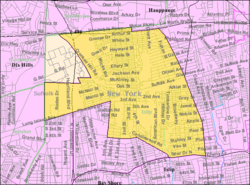Brentwood, New York
| Brentwood, New York | |
|---|---|
| Hamlet and census-designated place | |
| Nickname(s): The Jewel of Long Island | |
 U.S. Census map |
|
| location within the state of New York | |
| Coordinates: 40°46′54″N 73°14′39″W / 40.78167°N 73.24417°WCoordinates: 40°46′54″N 73°14′39″W / 40.78167°N 73.24417°W | |
| Country | United States |
| State | New York |
| County | Suffolk |
| Area | |
| • Total | 11.0 sq mi (28.4 km2) |
| • Land | 11.0 sq mi (28.4 km2) |
| • Water | 0.0 sq mi (0.0 km2) |
| Elevation | 79 ft (24 m) |
| Population (2010) | |
| • Total | 60,664 |
| • Density | 5,500/sq mi (2,100/km2) |
| Time zone | Eastern (EST) (UTC-5) |
| • Summer (DST) | EDT (UTC-4) |
| ZIP code | 11717 |
| Area code(s) | 631 |
| FIPS code | 36-08026 |
| GNIS feature ID | 0944688 |
Brentwood is a hamlet in the Town of Islip in Suffolk County, New York, United States. As of the 2010 Census, the population of Brentwood was 60,664.
In 1844, Brentwood began as Thompson Station and Suffolk Station, two new stations on the expansion of the mainline of the Long Island Rail Road.
On March 21, 1851, it became the utopian community named Modern Times. The colony was established on 750 acres (3.0 km2) of land by Josiah Warren and Stephen Pearl Andrews. In 1864, it was renamed Brentwood after the town of Brentwood, Essex, in England.
By contract, all the land in the colony was bought and sold at cost, with 3 acres (12,000 m2) being the maximum allowable lot size. The community was said to be based on the idea of individual sovereignty and individual responsibility. Individuals were encouraged to pursue their self-interest as they saw fit. All products of labor were considered private property. The community had a local private currency based upon labor exchange in order to trade goods and services (see Mutualism (economic theory)). All land was private property, with the exception of alleys which were initially considered common property but later converted to private property. Initially, no system of authority existed in the colony; there were no courts, jails or police. This appears to have given some credence to Warren's theories that the most significant cause of violence in society was most attributable to policies and law which did not allow complete individuality in person and property. However, the modest population of the colony might be considered a factor in this characteristic. The Civil War, as well as new residents that did not share the colony's philosophy, are said to have contributed to its eventual dissolution. Almost all of the original buildings that existed in Modern Times have been destroyed, aside from two Octagon houses, the original schoolhouse and a residence.
...
Wikipedia

